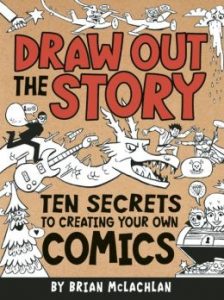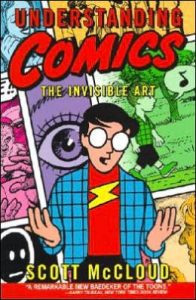(Originally published at Redeemed Reader on November 27, 2013)
Most kids enjoy comics or their upscale cousins, graphic novels. Of those who enjoy them, many will decide they want to create them. Does your son draw aliens and superheroes in his spare time? Does your daughter block out stories in panels? He or she might appreciate a little direction and a few pointers in how this medium actually works. Today, a recent how-to and a classic art manual to encourage the young graphic artist:
Draw Out the Story: 10 Secrets to Creating Your Own Comics, by Brian McLachlan. Owl Kids, 2013, 143 pages. Age/interest level: 10-14
Kids, 2013, 143 pages. Age/interest level: 10-14
There’s a lot more to creating comics than drawing ability. The “secrets” aren’t that secret, but some (like Take one moment at a time and Go beyond the normal) need some explaining. That’s what the author does, combining exposition, examples, and suggestions for practice. Each chapter explores one of the ten points and then provides several exercises for the aspiring graphic artist to pursue on his own. This is not a drawing manual; it assumes the reader can already draw well enough to play around with the exercises. Encountering this book before a kid feels fairly comfortable with his drawing skills may frustrate more than encourage.
It’s more about how to tell a story through pictures, with a lot of relevance for story writers as well. How to get ideas and develop them, how to show personality traits, how to brainstorm, as well as useful terms and tools and techniques of the trade—all will give the budding artist plenty to think about.
Understanding Comics: the Invisible Art, by Scott McCloud. HarperCollins, 1993, 215 pages. Age/interest level: 14-up.
 According to the author/artist, Will Eisner’s Comics and Sequential Art was the first book to explore comics as an art form. Scott McCloud’s is the second–a classic at twenty years of age. It’s much more than a how-to book; he delves into the science and philosophy of comics and their defining characteristic, which is time. McCloud uses the distinctives of the medium itself to explore the medium—that is, panels, dialogue boxes, and lots and lots of pictures. Art + Sequence receives plenty of ink, but also the mechanics of iconography, sense perception, the influences of fine art, the relationship between words and pictures, the uses of color, and the six steps to becoming a comic-book artist (of course it’s art!). His thoughts about icons and symbols and how the mind perceives them is especially interesting.
According to the author/artist, Will Eisner’s Comics and Sequential Art was the first book to explore comics as an art form. Scott McCloud’s is the second–a classic at twenty years of age. It’s much more than a how-to book; he delves into the science and philosophy of comics and their defining characteristic, which is time. McCloud uses the distinctives of the medium itself to explore the medium—that is, panels, dialogue boxes, and lots and lots of pictures. Art + Sequence receives plenty of ink, but also the mechanics of iconography, sense perception, the influences of fine art, the relationship between words and pictures, the uses of color, and the six steps to becoming a comic-book artist (of course it’s art!). His thoughts about icons and symbols and how the mind perceives them is especially interesting.
McCloud takes a materialist view of humanity and the art humans produce, with little or no spiritual dimension and occasional nods to unguided evolution (e.g., The natural world creates great beauty every day, yet the only rules of composition it follows are those of function and chance). That, plus the challenging concepts and the occasional references to sex, drinking, and drug use (none of them graphic) make this more appropriate for teens. But if you have a young artist who is serious about pursuing this medium, Understanding Comics might well be indispensable.
Emily has some interesting thoughts about the graphic medium here, particularly how it relates to boys. Be sure to check out our interviews with two Christian masters in the world of graphic storytelling: Sergio Cariello and Doug TenNapel. Also, our intern interview with Art Ayliss, founder and CEO of Kingstone Media Group, the leader in Christian comics publishing.
Stay Up to Date!
Get the information you need to make wise choices about books for your children and teens.
Our weekly newsletter includes our latest reviews, related links from around the web, a featured book list, book trivia, and more. We never sell your information. You may unsubscribe at any time.
Support our writers and help keep Redeemed Reader ad-free by joining the Redeemed Reader Fellowship.
Stay Up to Date!
Get the information you need to make wise choices about books for your children and teens.
Our weekly newsletter includes our latest reviews, related links from around the web, a featured book list, book trivia, and more. We never sell your information. You may unsubscribe at any time.
We'd love to hear from you!
Our comments are now limited to our members (both Silver and Golden Key). Members, you just need to log in with your normal log-in credentials!
Not a member yet? You can join the Silver Key ($2.99/month) for a free 2-week trial. Cancel at any time. Find out more about membership here.
3 Comments
Leave a Comment
You must be logged in to post a comment.




I’d love to know if you all have any recommendations on books to help someone learn to draw. I’ve always loved the idea of drawing but didn’t know where to start.
Anna, I’m not sure how old you are, but I’m guessing you’re not a toddler. : ) If you were a little younger, this post might help. https://redeemedreader.com/2013/04/inspiring-very-young-artists/. For beginners of any age, this series is one my kids have enjoyed: https://www.amazon.com/How-Draw-People-Dover/dp/0486420604/ref=sr_1_1?ie=UTF8&qid=1385744943&sr=8-1&keywords=how+to+draw. If you’re really serious about learning the principles of drawing, this is good for kids and adults: https://www.amazon.com/Drawing-With-Children-Creative-Beginners/dp/0874778271/ref=sr_1_1?ie=UTF8&qid=1385745024&sr=8-1&keywords=drawing+with+children. Hope that helps!
They totally tried and as you and I know the board. Of advisors of good ol boys are still trying to control what the public should read and that’s hypocrisy … from these relics http://www.dreamerwhounlocked.com